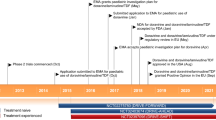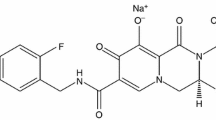Abstract
-
▴ Emtricitabine, a nucleoside reverse transcriptase inhibitor, is phosphorylated by cellular enzymes to emtricitabine 5′-triphosphate which, in turn, inhibits the activity of HIV-1 (HIV) reverse transcriptase by competing with the endogenous substrate. Incorporation of the triphosphate into the viral DNA causes chain termination, thereby inhibiting viral replication.
-
▴ In adult patients infected with HIV, combination therapy including emtricitabine 200mg once daily was as effective as triple therapy including lamivudine 150mg twice daily and significantly more effective than stavudine (at standard dosages) or protease inhibitor-based therapy at achieving and/or maintaining durable suppression of HIV levels after 24–48 weeks of therapy. In addition, 85% of emtricitabine recipients maintained virological success (<400 copies/mL) during 96 weeks of therapy.
-
▴ Triple therapy including emtricitabine 6 mg/kg once daily decreased (to <400 copies/mL) or maintained durable suppression of HIV RNA levels in ≈90% of children and adolescents (aged 13 months to 17 years) after 16–24 weeks of therapy.
-
▴ Emtricitabine-based therapy was generally well tolerated; most adverse events being mild to moderate in intensity. Emtricitabine-based regimens were as well tolerated as those with lamivudine, and better tolerated than those with stavudine.


Similar content being viewed by others
Notes
Use of tradenames is for product identification purposes only and does not imply endorsement.
References
Idemyor V. Human immunodeficiency viruses and drug therapy: resistance and implications for antiretroviral therapy. Pharmacotherapy 2002; 22(5): 659–62
Joint United Nations Program on HIV/AIDS/World Health Organisation. AIDS epidemic update [online]. Available from URL: http://www.unaids.org/worldaidsday/2002/press/update/epiupdate2002_en.doc [Accessed 2003 Aug 7]
Yeni PG, Hammer SM, Carpenter CCJ, et al. Antiretroviral treatment for adult HIV infection in 2002: updated recommendations of the International AIDS Society-USA Panel. JAMA 2002; 288(2): 222–35
Gilead Sciences. Emtriva (emtricitabine) capsules prescribing information [online]. Available from URL: http://www.gilead.com/pdf/emtriva.pdf [Accessed 2003 Jul 7]
AIDS Info. FDA approves emtricitabine — a new nucleoside reverse transcriptase inhibitor [online]. Available from URL: http://www.aidsinfo.nih.gov [Accessed 2003 Jul 3]
Sherwash D, Liotta D, Schinazi RF. Affinity of the antiviral enantiomers of oxathiolane cytosine nucleosides for human 2′-deoxycytidine kinase. Biochem Pharmacol 1993; 45(7): 1540–3
Schinazi R. Assessment of the relative potency of emtricitabine and lamivudine. J AIDS 2003; 34(2): 243–5
Hazen R, Lanier ER. Relative anti-HIV-1 efficacy of lamivudine and emtricitabine in vitro is dependent on cell type. J Acquir Immune Defic Syndr 2003; 32(3): 255–8
Schinazi RF, McMillian A, Cannon D, et al. Selective inhibition of human immunodeficiency viruses by racemates and enantiomers of cis-5-fluoro-1-[2-(hydroxymethyl)-1,3-oxathiolan-5-yl]-cytosine. Antimicrob Agents Chemother 1992; 36: 2423–31
Feng JY, Shi J, Schinazi RF, et al. Mechanistic studies show that (−)-FTC-TP is a better inhibitor of HIV-1 reverse transcriptase than 3TC-TP. FASEB J 1999 Sep; 13: 1511–7
Ussery MA, Wood OL, Kunder SC, et al. Anti-HIV activity in the HuPBMC SCID mouse model of six novel nucleoside analogs: (−)-FTC, (+/−)-FTC, D-DAPD, D-D4FC, CS-92 and CS-87 [abstract no. 33]. Antiviral Res 1998; 37: 49
Zeier M, Sanne I, Van der Berg M, et al. Efficacy and safety of emtricitabine triple combination therapy in HIV-1 infected treatment-naive male female patients [abstract no. I-1933]. 41st Interscience Conference on Antimicrobial Agents and Chemotherapy; 2001 Sep 22–25; Chicago, 346
McKinney R, Rathore M, Jankelovich S, et al. PACTG 1021: an ongoing phase I/II study of once-daily emtricabine, didanosine, and efavirenz in therapy-naive or minimally treated pediatric patients [abstract 873 plus poster]. 10th Conference on Retroviruses and Opportunistic Infections; 2003 Feb 10–14; Boston
Molina JM, Ferchel F, Rancinan C, et al. Once-daily combination of emtricitabine, didanosine, and efavirenz vs continued PI-based HAART in HIV-infected adults with undetectable plasma HIV-RNA: 48-week results of a prospective randomized multicenter trial (ALIZE-ANRS 99) [abstract plus poster]. 10th Conference on Retroviruses and Opportunistic Infections; 2003 Feb 10–14; Boston
Saez-Llorens X, Violari A, Ndiweni D, et al. Once-daily emtricitabine in HIV-infected pediatric patients with other antiretroviral agents [abstract no. 872 plus poster]. 10th Conference on Retroviruses and Opportunistic Infections; 2003 Feb 10–14; Boston
Saag M, Cahn P, Raffi F, et al. A randomized, double-blind, multicenter comparison of emtricitabine QD to stavudine BID [abstract plus oral presentation]. 42nd Interscience Conference on Antimicrobial Agents and Chemotherapy: Late Breaker Abstracts; 2002 Sep 27–30; San Diego, 8
Molina JM, Ferchal F, Rancinan C, et al. Once-daily combination therapy with emtricitabine, didanosine, and efavirenz in human immunodeficiency virus-infected patients. J Infect Dis 2000; 182(2): 599–602
Sanne I, Van Der Horst C, Shaw A, et al. Two randomized, controlled, equivalence trials of emtricitabine to lamivudine [poster no. 4432]. 14th International AIDS conference; 2002 July 7–12; Barcelona
Van der Horst C, Benson C, Rodriguez A, et al. Long-term efficacy and safety of emtricitabine (FTC) in HIV+ adults switching from a lamivudine (3TC) containing HAART regimen [abstract no. I-1932]. 41st Interscience Conference on Antimicrobial Agents and Chemotherapy; 2001 Sep 22–25; Chicago
Schinazi RF, Lloyd RM, Nguyen M-H, et al. Characterization of human immunodeficiency viruses resistant to oxathiolanecytosine nucleosides. Antimicrob Agents Chemother 1993; 37(4): 875–81
Tisdale M, Kemp SD, Parry NR, et al. Rapid in vitro selection of human immunodeficiency virus type 1 resistant to 3′-thiacytidine inhibitors due to a mutation in the YMDD region of reverse transcriptase. Proc Natl Acad Sci USA 1999; 90: 5653–6
Borroto-Esoda K, Harris J, Shaw A, et al. Lower incidence of the M184V mutation in patients receiving combination therapy with emtricitabine (FTC) compared to lamivudine (3TC) [poster no. 88]. 5th International Workshop on Drug Resistance and Treatment Strategies; 2001 Jun 4–8; Scottsdale (AZ)
Harris J, Shaw A, Borroto-Esoda K, et al. Genotypic analysis of HIV-1-infected antiretroviral therapy-naive patients receiving emtricitabine (FTC) or lamivudine (3TC) in a double-blind equivalence trial [poster no. 104]. 5th International Workshop on Drug Resistance and Treatment Strategies; 2001 Jun 4–8; Scottsdale (AZ)
Sanne I, Quinn JB, Harris J, et al. Genotypic analysis of HIV-1 infected ART-naive patients receiving emtricitabine (FTC) or lamivudine (3TC) in a double blind equivalence trial [poster no. 4433]. 14th International Aids Conference; 2002 Jul 7–12; Barcelona
Szczech GM, Wang LH, Walsh JP, et al. Reproductive toxicology profile of emtricitabine in mice and rabbits. Reprod Toxicol 2003; 17(1): 95–108
Cui L, Schinazi RF, Gosselin G, et al. Effects of β-enantiomeric and racemic nucleoside analogues on mitochondrial functions in HepG2 cells. Biochem Pharmacol 1996; 52: 1577–84
Frick LW, Lambe CU, St John L, et al. Pharmacokinetics, oral bioavailability, and metabolism in mice and cynomolgus monkeys of (2′R,5′S-)-cis-5-fluoro-1-[2-(hydroxymethyl)-1,3-oxathiolan-5-yl] cytosine, an agent active against human immunodeficiency virus and human hepatitis B virus. Antimicrob Agents Chemother 1994; 38: 2722–9
Frick LW, St John L, Taylor LC, et al. Pharmacokinetics, oral bioavailability, and metabolic disposition in rats of (−)-cis-5-fluoro-1-[2-(hydroxymethyl)-1,3-oxathiolan-5-yl] cytosine, a nucleoside analog active against human immunodeficiency virus and hepatitis B virus. Antimicrob Agents Chemother 1993; 37: 2285–92
Moore LE, Ni L, Boudinot FD, et al. Pharmacokinetics of (−)-2′,3′-dideoxy-5-fluoro-3′-thiacytidine [(−)-FTC] and its metabolites in rhesus monkeys [abstract no. 93]. Antiviral Res 1997; 34: 68
Wang LH, Gardner P, Frick LW, et al. Pharmacokinetics and safety of 524W91 following single oral administration of escalating doses in HIV-infected volunteers [abstract no. A129]. 35th Interscience Conference on Antimicrobial Agents and Chemotherapy; 1995 Sep 17–20; San Francisco
Painter GR, St Clair M, Ching S, et al. 524W91: anti-HIV, antihepatitis B virus. Drugs Future 1995 Aug; 20: 761–5
Wang LH, Delehanty J, Blum MR, et al. FTC: a potent and selective anti-HIV and anti-HBV agent demonstrating desirable pharmacokinetic characteristics [abstract no. 415]. Clin Infect Dis 1998; 27: 999
Lascoux-Combes C, Peytavin G, Perusat S, et al. Pharmacokinetics (PK) of once-daily combination therapy with emtricitabine, didanosine and efavirenz in treatment naive HIV-infected adults (ARNS 091 trial) [abstract no. P222]. 8th European Conference on Clinical Aspects and Treatment of HIV-Infection; 2001 Oct 28–31; Athens, 148
Wang LH, Blum MR, Hui J, et al. Lack of significant pharmacokinetic interactions between emtricitabine and other nucleoside antivirals in healthy volunteers [abstract no. A-505]. 41st Interscience Conference on Antimicrobial Agents and Chemotherapy; 2001 Sep 22–25; Chicago
Wiznia AA, Wang LH, Rathore MH, et al. An evaluation of the pharmacokinetics and safety of single oral doses of emtricitabine (FTC) in HIV-infected or exposed children [abstract no. 1665 plus poster]. 40th Interscience Conference on Antimicrobial Agents and Chemotherapy; 2000 Sep 17–20; Toronto
Wang LH, Begley J, Feng JY, et al. Pharmacokinetic and pharmacodynamic characteristics of emtricitabine supports its once daily dosing [poster no. 4546]. 14th International Aids Conference; 2002 July 7–12; Barcelona
Blum MR, Begley J, Zong J, et al. Lack of a pharmacokinetic interaction between emtricitabine and tenofovir DF when coadministered to steady state in healthy volunteers [poster no. A-1621]. 43rd Annual Interscience Conference on Antimicrobial Agents and Chemotherapy; 2003 Sep 14–17; Chicago
Zong J, Blum MR, Chittick G, et al. Steady-state evaluation of the potential pharmacokinetic interactions between emtricitabine and zidovudine in healthy volunteers. 43rd Annual Interscience Conference on Antinicrobial Agents and Chemotherapy; 2003 Sep 14–17; Chicago
Shaw AL, Shen G, Wakeford JB, et al. Once-daily emtricitabine compared to twice-daily abacavir within a HAART regimen in antiretroviral drug-naive HIV-1 infected patients (ODECTA) [abstract no. 547]. Antiviral Ther 2003; 8 Suppl. 1: S331
Molina JM, Perusat S, Ferchal F, et al. Once-daily combination therapy with emtricitabine, didanosine and efavirenz in treatment-naïve HIV-infected adults: 64-week follow-up of the ANRS 091 trial [abstract 321]. 8th Conference on Retroviruses and Opportunistic Infections; 2001 Feb 4–8; Chicago
Molina JM, Ferchal F, Journot V, et al. Once-daily combination therapy with emtricitabine, didanosine and efavirenz in treatment naïve HIV-infected adults: 96-week follow-up of the ANRS 091 trial [abstract plus poster]. 8th European Conference on Clinical Aspects and Treatment of HIV-Infection; 2001 Oct 28–31; Athens, 148
Rousseau FS, Kahn JO, Thompson M, et al. Prototype trial design for rapid dose selection of antiretroviral drugs: an example using emtricitabine (Coviracil). J Antimicrob Chemother 2001 Oct; 48(4): 507–13
Delehanty J, Wakeford C, Hulett L, et al. A phase I/II randomized, controlled study of FTC versus 3TC in HIV-infected patients [abstract no. 16]. 6th Conference on Retroviruses and Opportunistic Infections; 1999 Jan 31–Feb 4; Chicago
Owens J. Emtricitabine (Emtriva) outperforms stavudine in 60 weeks of HIV treatment [online]. Available from URL: http://www.docguide.com/news/content.nsf [Accessed 2003 Jul 17]
Wakeford C, Shen G, Hulett L, et al. Long-term efficacy and safety of emtricitabine (FTC) in HIV+ adults switching from a lamivudine (3TC) containing HAART regimen [poster no. 550]. 10th Conference on Retroviruses and Opportunistic Infections; 2003 Feb 10–14; Boston
Sanne I, Saag M, Shaw A, et al. Efficacy of emtricitabine (FTC) in HIV-infected patients with high pre-treatment viral load [abstract no. 546]. Antiviral Ther 2003; 8 Suppl. 1: S330
Bartlett J. Severe liver toxicity in patients receiving two nucleoside analogues and a non-nucleoside reverse transcriptase inhibitor [abstract no. 19]. 8th Conference on Retroviruses and Opportunistic Infections; 2001 Feb 4–8; Chicago
Author information
Authors and Affiliations
Corresponding author
Rights and permissions
About this article
Cite this article
Bang, L.M., Scott, L.J. Emtricitabine. Drugs 63, 2413–2424 (2003). https://doi.org/10.2165/00003495-200363220-00003
Published:
Issue Date:
DOI: https://doi.org/10.2165/00003495-200363220-00003




